Home-Field Advantage
The minivan is dwarfed by the loading dock at Gordon Commons, so it pulls up several feet short of where trailer trucks routinely make deliveries for the university’s main commissary. The driver, Kris Hansen, hops out with two waxed-cardboard produce boxes. Inside are a dozen heads of mixed lettuces and four pounds of loose arugula leaves — produce that will show up among the offerings at UW–Madison’s Liz Waters residence hall later in the week.
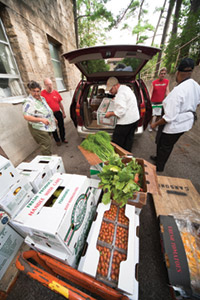
Whether produce is delivered from local farms to the Gordon Commons loading dock, above, or from the nearby Kitchen Garden at the Allen Centennial Gardens, left, it doesn’t have far to travel.
Hansen and his wife, Deb, distribute produce and other products from several dozen Wisconsin family farms through their company, Simply Wisconsin. During the height of the growing season, they make weekly deliveries to campus, bringing locally grown fruits and vegetables that dot the menus of dining facilities managed by University Housing. Unlike most food prepared in the commissary, which arrives from distributors chopped, washed, and ready to serve, Simply Wisconsin’s food shows up whole and unprocessed. It also comes in significantly smaller batches, a point underscored when Hansen has to hustle back to move his van out of the path of a Sysco semi that is pulling into the dock.
Surrounded by farmland and the home of the well-known Dane County Farmers’ Market, Madison is a hotbed of consumer interest in foods such as those delivered by Simply Wisconsin. Trendy restaurants proudly feature locally sourced ingredients, and some grocery stores label displays with the number of “food miles” items have traveled. Community gardens abound, and, through the Madison Area Community Supported Agriculture Coalition, some twelve thousand area households own shares in nearby farms, entitling them to regular deliveries of produce fresh from the field.
It should be no surprise that the trend has reached UW–Madison — a campus with both close historical links to state agriculture and thousands of mouths to feed each day. For a decade, University Housing’s Dining and Culinary Services and UW Hospital and Clinics have worked steadily to buy more locally grown foods and feature them in menus. Housing, for example, spent close to $900,000 on foods produced locally and another $2.3 million on locally manufactured items, such as processed meats and pre-cut fruits and vegetables, during the 2009–10 academic year. The unit has partnered with the student group Slow Food UW to offer weekly meals featuring locally grown foods at campus dining rooms and has even staged a Top Chef-style competition among its cooks using local ingredients.
“[Local food] has very strong ties to this campus and what this campus stands for,” says Julie Luke, the associate director of Housing’s dining services. “Why wouldn’t we try to reap the bounty of that?”
But despite ongoing efforts by Luke and others, local foods still represent a modest bite of the overall institutional pie. Housing’s $900,000 in local food expenditures for 2009–10 amounted to just 11 percent of its total food budget, with much of that share from dairy — including milk, cheese, and ice cream produced at the UW’s own dairy plant in Babcock Hall. Compared to the standard fare of pre-processed staples in industrial-sized packages, a few heads of fresh lettuce can seem as out of scale as the minivan that delivered them.
Why isn’t it easier to be a locavore — a term coined to describe those who are interested in eating local food — in UW–Madison’s cafeterias? That paradox has drawn the interest of several researchers, teachers, and food-service managers on campus, and together they are beginning to understand the complexities involved in something that sounds as simple as eating local.
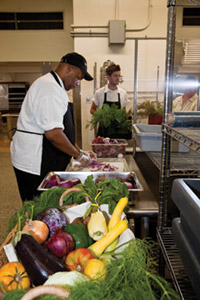
Locally grown foods, arriving whole and unprocessed, mean a lot of washing and chopping — unlike the massive amounts of pre-prepped ingredients used for the meals University Housing serves in multiple campus locations every day.
Economies of Scale
Walk through Housing’s vast commissary at Gordon Commons, and you can begin to understand some of the realities of an operation that serves seventeen thousand meals each day at multiple venues across campus. This is not your grandmother’s kitchen. The long, hangar-like space is designed more for mass production than traditional cooking. An entire wall of ovens looms near a walk-in cooler brimming with racks of bagged and washed vegetables, massive tubs of fruits, and vats of condiments. A row of electric mixers, each several feet tall, lines the back wall.
In such settings, unprocessed produce poses many challenges. For starters, the quantities of food that move through institutional kitchens are mind-boggling. “We buy probably three tons of produce a week,” says John Hofman, who directs food services for the UW Hospital and Clinics. “I’m not exactly going down to the farmers’ market and picking this out.”
Washing and chopping that much fresh food requires more time, space, and staff than most dining operations have. It also creates a supply issue. With so much food to prepare on tight turnaround, managers such as Hofman have to rely on large suppliers who can predictably fill big orders.
“If you’re my poultry vendor, and I call up and say I need ten boxes of chicken breast, and you only have three, then what do I do?” he asks. “How much time do I have to look for those chicken breasts? About an hour.”
Some local producers have attempted to address that problem by pooling their goods into centralized distribution. Starting in 2008, Housing and the UW Hospital signed up with Badgerland Produce, a nonprofit cooperative in Montello, Wisconsin, to buy produce from some two hundred member-growers. In addition to hosting a central food auction, Badgerland offered fixed-price contracts for pre-harvest orders, allowing institutional buyers such as Hofman and Luke to budget their menus.
Although the contracts with Badgerland did bring more local produce to campus, it hasn’t necessarily meant high visibility. Luke says Housing’s buyers have followed a low-risk strategy: instead of relying on locally grown food for fixed-menu items, they focus on salad bars and special events, where items wouldn’t be missed if an order fell through. They also have experimented with processing homegrown vegetables for later use; in fall 2009, the staff devoted a considerable chunk of time to cleaning, chopping, and freezing locally grown sweet onions.
Luke hopes such efforts will help Housing meet a goal of buying 15 percent of its food locally by the end of this academic year. But she admits onions won’t carry them over the threshold. They recently worked with a distributor to try to find in-state sources for all of the shredded mozzarella cheese they use on pizza. “That should really up our percentage,” she says. “We serve a lot of pizza.”
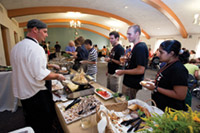
University Housing is steadily buying more locally produced foods and featuring them in menus served in its dining facilities and at special events. Photo: Wolfgang Hoffmann
Regional Systems Have Potential
However they are achieved, the percentages of local food served in campus eateries are of keen interest to people such as Michelle Miller ’83, MS’93, associate director of the Center for Integrated Agricultural Systems (CIAS) in the College of Agricultural and Life Sciences. For local food to become a meaningful player in the overall food system — and not just the purview of farmers’ markets and niche restaurants — institutional markets have to buy in, she says.
“Most people don’t get their food at farmers’ markets and farm stands,” Miller says. “If we’re really serious about feeding ourselves [with local food] at least part of the year, then we need to scale up — to increase production and redevelop the necessary infrastructure to make our regional food system efficient.”
The potential is certainly there. In Wisconsin, demand for locally produced goods consistently outstrips supply, and Miller maintains that expanding capacity would prove profitable for the local economy. She cites a 2010 report, published by the Leopold Center for Sustainable Agriculture at Iowa State University in partnership with CIAS, which calculated that increasing local fruit and vegetable production to meet the demand of regional metropolitan areas could add up to an estimated $72 million in farm sales and more than eight hundred jobs in Wisconsin.
“We’ve got our own markets here in Wisconsin, but Chicago is untapped,” she says. “Chicago has huge potential as a market for sustainably produced and delivered food. It is not the market that is missing; it is the infrastructure.”
Miller and other UW researchers are exploring what could help local and regional food expand into those bigger markets. With a grant from the Ira and Ineva Reilly Baldwin Wisconsin Idea Endowment, CIAS and the UW-Extension Agricultural Innovation Center examined eleven organizations across the country that are trying to move local foods into wholesale settings.
Their report, released in December 2009, concluded that the biggest obstacles relate to product consistency — quality, quantity, and timing of availability — largely due to absent infrastructure. Consolidation services such as Badgerland offer one way to handle those challenges, the authors say. But Miller says local and state governments need to back up organizational efforts with policies that ease and encourage such distribution networks. One such measure — a bill introduced last year in the Wisconsin senate — would have required state entities with annual food expenditures greater than $25,000 to aim for spending at least 10 percent of that money on products grown, processed, packaged, and distributed in Wisconsin by 2020, with the target increasing to 20 percent thereafter. Although that bill failed, most observers expect the push for legislative support of local food sourcing to resurface.
But policy debates are also likely to trigger lively discussions about exactly what it means to buy local. Clearly a dirt-grown tomato harvested by an Amish farmer near Montello, Wisconsin, and driven to Madison in a Badgerland truck is local, and clearly a hydroponic tomato grown in California and shipped two thousand miles in a plastic clamshell package is not. But what about a chicken raised out of state, but processed by a family-owned business fifty miles outside Madison? Milk collected in Wisconsin, shipped out of state for bottling, then shipped back to sell?
“We have to come up with some criteria,” says Housing’s Julie Luke. “What’s reasonable to label local — if it has one ingredient in it, or if it’s some percent of the ingredients?”
Luke describes Housing’s guidelines as fairly conservative, counting as local only those items grown or produced in Wisconsin. For now, they tally locally processed goods such as meats and Wisconsin-prepped, out-of-state fruits and veggies separately. But even these choices reveal gray areas about what fits the real spirit of the local-food movement. For some, the decision to eat local food is tied to the perceived environmental benefits of reducing food miles. For others, it’s about fostering a sense of community with growers and fellow eaters. Many say that it’s ultimately about taste and freshness.
“Oftentimes, the issue of sourcing locally is presented as a very simple solution,” says Monica Theis ’79, MS’88, a UW food science instructor. “And it’s simply not.”

A bountiful table awaits diners, thanks to staff at University Housing’s Dining and Culinary Services who transformed locally grown fruits into luscious desserts.
Losing the Story
In a small plot of vegetables in Allen Centennial Gardens, Theis has been exploring those complexities from the ground up. With the help of Allen director Ed Lyon MS’01, she planted the garden in 2008 as a research and educational tool for her students. It has become a modest demonstration of the joys and pitfalls of growing and serving food close to home. For the past two summers, food-service staff have carted greens, tomatoes, onions, and other vegetables grown in the garden across a parking lot to be processed in Housing’s kitchens, earning the prize for the shortest food-miles of any item on campus.
“Being a university, we are well positioned to study and learn the practical realities of sourcing locally,” says Theis. “I hope, personally and professionally, that we are able to address some of these challenges — like cost, access, volume, and safety — that are not well understood.”
One problem with locally grown food, for instance, is how to let consumers know where it came from. Cafeteria lines aren’t like farmers’ markets, where consumers can make a clear connection to the farmer who grew their food. In a salad bar, locally grown tomatoes may sit side-by-side with long-distance travelers, and no one may appreciate the difference.
The CIAS report cites this problem of “losing the story” of local food as a chief impediment to institutions delivering a rewarding experience for diners. Housing has experimented with signs and themed meals that feature local foods, but Luke says it’s still a challenge to show consumers what they’re buying. “We need to do a better job,” she says. “That’s one of our projects.”
But that is not the most immediate barrier in UW cafeterias, where scaling up locally grown foods must be measured against budget realities. While many produce items are comparable or even less expensive when bought locally during the growing season, others, especially meat, are considerably more costly. At Housing, some of that burden can be shared with diners because items are purchased a la carte. But that’s not the case for many schools and hospitals, where fixed food budgets offer less room to experiment.
“When you’re serving 2.5 million meals a year, if your cost per meal goes up 10 cents, that’s $250,000,” says Hofman. “The pennies are important.”
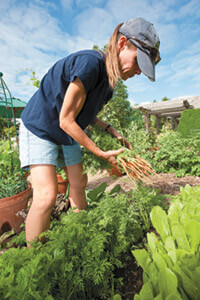
Monica Theis, a UW food science instructor, pulls carrots at a small plot in Allen Centennial Gardens. The garden’s bounty is truly “local food” — deliveries require a mere trip across a parking lot to University Housing’s kitchens. Photo: Bryce Richter
The university’s local purchases took another unexpected hit when Badgerland Produce closed last year, apparently due to sourcing issues. “It’s disappointing,” Luke says, “but it gets to the heart of the issue.”
Meanwhile, Theis’s vegetable garden, like the larger campus initiatives it symbolizes, has had its own successes and challenges. When the usual staff members were temporarily unable to make it to the plot last summer, the lettuces weren’t harvested.
Theis sees her overgrown greens as a reflection of the bigger issues facing institutional local foods. “I see myself as a very optimistic person. But there are some pretty hard realities, especially in the public sector,” she says. “I’m convinced there are steps we can take, but it’s not going to be a quick or simple revolution.”
Jill Sakai, a writer for University Communications at UW–Madison, enjoys being on a first-name basis with the farmers who grow most of her produce.
Published in the Spring 2011 issue
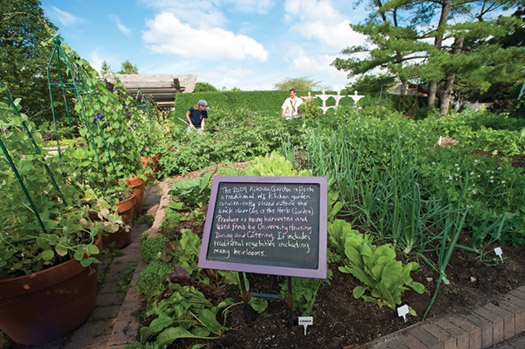

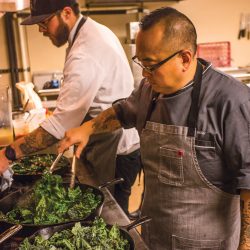
Comments
No comments posted yet.